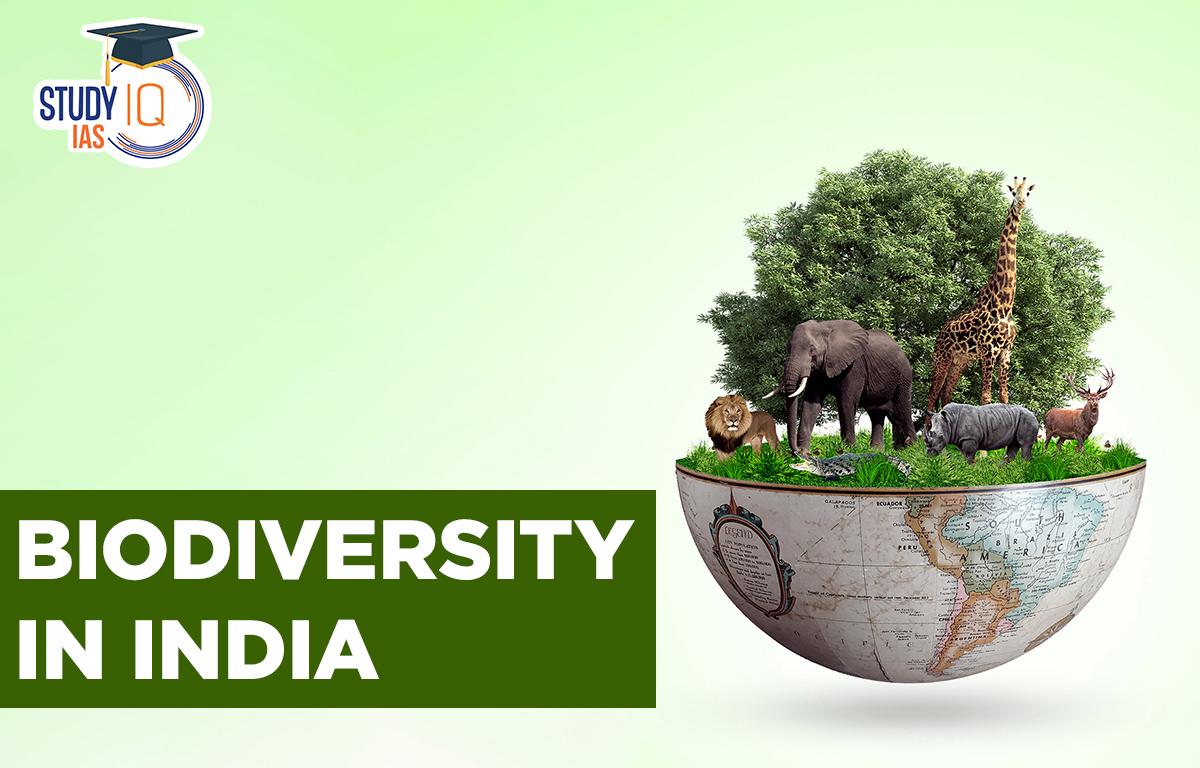Table of Contents
Biodiversity
The variety of living things, including those in aquatic, marine, and terrestrial habitats is known as biodiversity. It plays important ecological, economic, and social roles, helping to maintain balance among species. It has developed over 4.5 billion years and is now heavily influenced by humans. Biodiversity supports many things we need, such as food, water, medicine, and a stable climate. Over half of the world’s economy relies on nature, and more than 1 billion people depend on forests for their livelihoods.
What does Biodiversity mean?
The overall quantity and variety of species in a certain area or region is referred to as the region’s biodiversity. It covers diversity within and between species as well as diversity in the ecosystem. The two main parts of biodiversity are species richness and species evenness. Whittaker carried out the biodiversity measurement.
- Species Richness: Species richness refers to the variety of species found in a population. Alpha diversity, beta diversity, and gamma diversity are its three subtypes.
- Species Evenness – The measure of species proportion at a particular site is species evenness.
Types of Biodiversity in India
Here are 3 main types of Biodiversity in India:
- Genetic Diversity (Diversity within species)
- Species Diversity (Diversity between species)
- Ecosystem Diversity (Diversity between ecosystem)
Genetic Diversity
A single species’ individuals are all genetically unique from one another. Genetic diversity refers to the genetic diversity among any species of plant or animal. Two people who are connected closely share more genetic information and are therefore more similar.
Species Diversity
Species diversity refers to the variety of different species in an area. This includes both natural ecosystems and agricultural areas. Tropical regions have over 85000 types of flowering plants. North and South America, along with tropical Asia, have more than 50,000 species, while tropical Africa has around 35000. Europe has about 11300 vascular plant species. Fewer species can be found in harsher environments like dirty streams or salt flats.
Ecosystem Diversity
There is a wide range of various ecosystems, each with unique species. This ecosystem differs from one another depending on the habitats and species present. You can find this ecosystem diversity in a particular geographic area, a nation, or a state. Along with these other types of diversity, mountains, deserts, and grasslands are present.
Biodiversity Hotspots in India
India has six hotspots of biodiversity out of the 36 biodiversity hotspots, making it a country rich in biodiversity. With a great array of flora and animals in India (including endangered species).
- The Himalayas,
- the Indo-Burma region,
- the Terrai-duar Savannah,
- the Western Ghats,
- Sundaland, and the Sunderbans are among India’s hotspots for biodiversity. India’s Sunderbans is another UNESCO World Heritage Site. The following is a detailed summary of India’s Hotspots for Biodiversity-
Himalayas
One of the main Indian hotspots is the Eastern Himalayas. It covers the regions of Burma, Nepal, Bhutan, Sikkim, and Arunachal Pradesh. It has an evergreen forest with oak and alpine trees in it. The wildlife includes the fascinating western tragopan, clouded leopard, slow loris, snow cock, heron, tiger, white-winged wood duck, and Indian civet.
Terrai-duar Savannah
The Terrai-duar Savannah extends to the Indo Gangetic plain of Bhutan, Nepal, and India after forming a brief sliver at the foot of the Himalayas. The Terrai-duar Savannah is known for its tall and rich grasslands, which are some of the rarest in the world. These grasslands are shaped by strong monsoon floods each year. Notable wildlife in the area includes the one-horned rhinoceros, sloth bears, and Asian elephants.
Indo-Burma region
The Indo-Burma region is one of India’s largest biodiversity hotspots. It includes the Ganga plains, parts of the Andaman and Nicobar Islands, and areas in Thailand, Myanmar, Cambodia, and Laos. This region is home to many endangered plants and animals, like the Annamite muntjac and grey-crowned crocias. However, it faces increasing threats from human activities, making legal protection essential.
Sunderbans
In the Ganga-Brahmaputra delta, there are 104 islands collectively known as the Sunderbans. With the largest mangrove forest in the world, Sunderbans is one of India’s UNESCO World Heritage Sites. The Royal Bengal tigers live there. Along with Gangetic dolphins and estuarine crocodiles, as well as several other fish, animal, and bird species, it is home to Royal Bengal tigers. But today, the rise in sea level brought on by global warming poses a serious threat to the local species.
Sundaland
The Nicobar Islands are home to India’s Sundaland hotspot, which reaches the tectonic plates beneath the Indian Ocean. Probscis monkeys, Javan and Sumatran rhinoceros, pig-tailed langurs, and orangutans are among the animals that call it home. Only the probosci’s monkeys of this group are present in the Borneo region. Also, the Sundaland hotspot is home to the rafflesia, the largest bloom in the world (it measures one metres long).
Western Ghats
Beyond India’s west coast, the Western Ghats extends from north to south. With numerous highland tropical rainforests, it is also one of the UNESCO World Heritage Sites. A wide range of animals and plants can be found in these forests. Tigers, black panthers, and leopards are all part of it. The endangered shy lion-tailed macaques are part of the fauna in the southern Western Ghats. The strange pig-nosed purple frog is seen in the Western Ghats during monsoon season. In the dense forests, new species are continuously being found.
Importance of Biodiversity
Biodiversity is essential for keeping the ecosystem balanced. It plays important roles in ecology, the economy, and science. Here are the key reasons why biodiversity matters:
Ecological Role
A diverse habitat gives species a better chance to survive threats. This helps protect them and maintain ecological balance. Biodiversity is important for human survival as it helps store energy, produce organic material, support the water cycle, and regulate the climate.
Economic Role
Biodiversity, especially agro-biodiversity, is essential for our daily lives. It is important for growing food crops, raising livestock, fishing, and providing raw materials for cosmetics, food, and medicine.
Scientific Role
The species, whether extinct or still existing, helps in comprehending the idea of evolution. It aids in comprehending the function and role carried out by a species in a specific ecosystem and demonstrating their various relationships.
Other Roles
In addition to these responsibilities, maintaining the food web, pollination, nutrient cycling, lowering greenhouse gas emissions, soil formation, etc.
Threats to Biodiversity
Changes to our land- and water-use
Numerous diverse ecosystems exist on our land and in our oceans, and business activities have an impact on these ecosystems. For example, when construction companies drain and fill in wetlands or marshes to make place for housing, they remove the area that normally collects extra rainwater during storms.
Excessive consumption and unsustainable exploitation
Logging, farming, and fishing can be done responsibly, but they often lead to overusing resources. If too many species are taken from an area, or even just a few important ones, it can harm the entire ecosystem.
Climate change
Already, we are experiencing hotter weather, warmer oceans, and more extreme storms. Since many animals can not adapt to these circumstances, their populations plummet.
Increase in pollution
For many ecosystems, pollution of the air, soil, and water is a major issue. Fish, birds, and other marine creatures accumulate tiny plastic particles that are suspended in the ocean’s water. Many species in rivers and lakes are wiped out by industrial poisons. The soil, leaves, and water are all contaminated by air pollution. Less species, less diversity, and weaker ecosystems are the end results of all of this.
Invasive species
Global trade moves species from their original homes to new places, where they often don’t have natural predators to keep their numbers in check. This can lead to problems, especially with harmful species like disease-carrying mosquitoes, which can thrive in these new areas due to climate change. These invasive species can disrupt the balance of their new environments.
Conservation of Biodiversity
The ecosystem and natural habitats must be preserved, protected, and managed as part of the conservation of biodiversity. Conservation of biodiversity comes in two flavors-
In-situ conservation
In-situ conservation is the preservation of biodiversity in its native habitat. Think about places like sanctuaries, national parks, protected forests, and biosphere reserves. The main goals of in-situ conservation are:
- Protecting and managing these areas for the long term.
- Creating plans to preserve local wildlife and plants.
- Connecting important areas to prevent habitat loss.
- Enforcing laws to protect species.
- Sharing knowledge and raising awareness about conservation.
- Encouraging eco-friendly tourism in sensitive areas.
Ex-situ conservation
Ex-situ conservation refers to the preservation of biodiversity outside of its natural habitat. Examples include
- DNA repositories,
- cryopreservation,
- zoological parks,
- wildlife safari parks,
- botanical gardens,
- seed banks,
- sperm banks, and
- collections of living organisms for scientific research and development.
Importance of Biodiversity
Ecosystem Services
- Protection of water resources– It protects against extreme events like floods and droughts by regulating and stabilizing water runoff and maintaining the hydrological cycles.
- Soil protection– It will support soil preservation and moisture and nutrient retention.
- Nutrient storage and cycling-It will support the ecosystem’s ability to recycle nutrients contained in the soil and the atmosphere.
- Pollution reduction– It is crucial for maintaining the gaseous makeup of the environment, breaking down waste, and getting rid of contaminants.
- Climate stability-Through both macro and micro-level vegetation, it stabilizes the climate.
- Maintenance of ecological process– It will support the preservation of the food chain, which is a logical succession of living things through which nutrients and energy are transferred when one organism consumes another.
Biological Resources
- Species of plants used as food, fibre, medicines, fuel, and ornamentals
- Breeding material for crop improvement- Genes from wild cousins of domesticated crop plants are extremely helpful for crop development program.
- Future resources-The preservation of biological diversity and the development of new biological resources are closely related because local knowledge of the usage of wild plants serves as a fertile ground for new plant product ideas.
Social Benefits
- Recreation-The best locations for ecotourism, photography, painting, filmmaking, and literary works are in forests, wildlife, national parks, biosphere reserves, and sanctuaries.
- Cultural values- Species of plants and animals play a significant role in human culture. It exists in parallel because different communities can each develop a unique cultural identity through their environment and biological variety. Consider the Bishnoi Community. Plants considered sacred and venerated include Tulsi (Ocimum sanctum), Peepal (Ficus religiosa), and Khejri (Prosopis cineraria).
Biodiversity Act 2002
India’s Biological Diversity Act of 2002 was created to support the 1992 United Nations Convention on Biological Diversity (CBD). This law allows states to manage their own biological resources. The important features are as follows:
- To obtain biological resources from India for research or commercial use, approval from the National Biodiversity Authority (NBA) is required.
- The act establishes a three-tier system for regulating access:
- National Biodiversity Authority (NBA): Oversees regulation and supervision.
- State Biodiversity Boards (SBBs): Manage biodiversity at the state level.
- Biodiversity Management Committees (BMCs): Operate at the local level.
- These bodies receive special funding for research and conservation.
- The NBA ensures sustainable use of resources and manages investments for conservation.
- The Central Government designates institutions to store biological resources and helps protect threatened species.
- Complaints about benefit-sharing or NBA/SBB decisions can be addressed to the National Green Tribunal (NGT).
- Commonly traded biological resources and traditional uses are exempt from these regulations.
- Collaborative research with foreign institutions requires approval and may also be exempted.
Biological Diversity Act, 2002 Objectives
By maintaining and regulating the appropriate use of its components and guaranteeing fair distribution of the benefits gained from such usage, the Act aims to conserve biological variety. The Act’s claimed objectives include safeguarding traditional knowledge, fighting biopiracy, forbidding individuals from obtaining patents without the consent of the government, and more.
The development of national plans and program for biodiversity conservation, the power granted to state governments to notify and preserve biodiversity areas, and the central government’s authority to notify species that are gravely endangered, on the verge of extinction, threatened species, and prohibited species are some of the aspects of the goal of aiming to conserve biological diversity.
While regularizing the use of natural resources rather than depleting them would constitute sustainable usage of its component. The benefit-sharing provision aims to establish equitable benefit-sharing from accessing biological resources, byproducts, knowledge, and practice in accordance with the terms and conditions set forth by the party requesting such benefits and the relevant local bodies.
Other Indian Geography Topics
Other Fundamental Geography Topics


 Story of Meera Bai and Her Devotion For ...
Story of Meera Bai and Her Devotion For ...
 Desert Climate, Distribution, Climatic C...
Desert Climate, Distribution, Climatic C...
 Deserts of India Map, Features of Thar D...
Deserts of India Map, Features of Thar D...





















